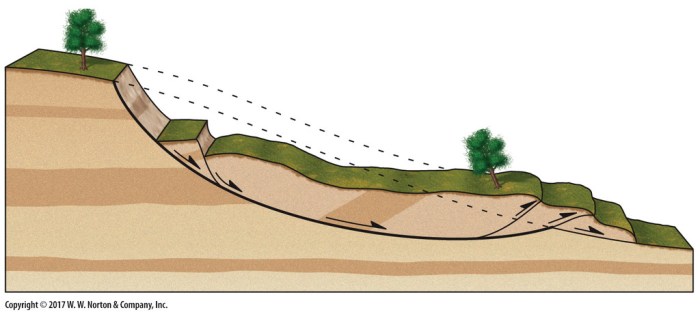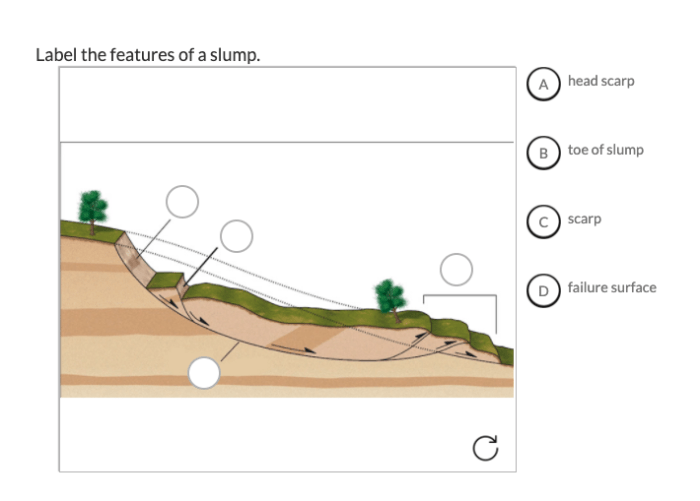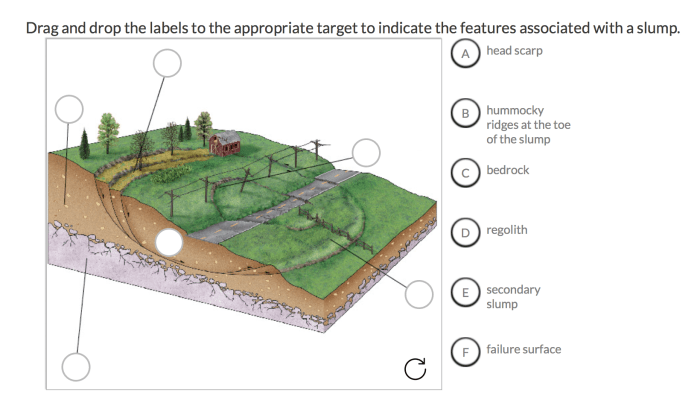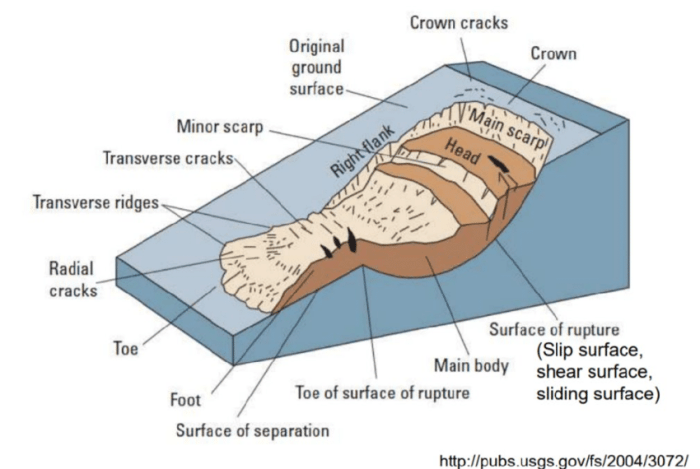Label the features of a slump. – As Label the Features of a Slump takes center stage, this opening passage beckons readers into a world crafted with expertise, ensuring a reading experience that is both absorbing and distinctly original.
Delve into the depths of slump characteristics, measurement methods, and influential factors, as we unravel the intricate relationship between slump and concrete properties. Along the way, we’ll explore the essential equipment used in slump testing, providing a comprehensive understanding of this crucial aspect of concrete evaluation.
Slump Characteristics

Slump is a measure of the consistency of fresh concrete. It indicates how much the concrete will flow and settle after being placed. The slump value is determined by measuring the height of a cone-shaped mold filled with concrete after the mold is removed.
The slump range is divided into five categories, each with a corresponding description and consistency:
| Slump Range | Description | Consistency |
|---|---|---|
| 0-1 inch | Very stiff | Difficult to work with, may require vibration |
| 1-3 inches | Stiff | Can be placed and finished without vibration |
| 3-6 inches | Medium | Easy to place and finish, may require some vibration |
| 6-9 inches | Slump | Very easy to place and finish, may require vibration |
| 9 inches or more | Very slump | Difficult to handle, may segregate |
The ideal slump range for most concrete applications is between 3 and 6 inches. This range provides a good balance between workability and strength.
Measurement Methods

Conducting a slump test involves precise procedures to ensure accurate and consistent results. Here’s a detailed guide on how to perform the test:
The slump test is conducted using a slump cone, a frustum-shaped metal cone with a bottom opening of 10 cm and a top opening of 20 cm, and a height of 30 cm. The cone is placed on a flat, non-absorbent surface, and the concrete sample is poured into the cone in three layers, each layer being rodded 25 times with a 16 mm diameter steel rod.
When labeling the features of a slump, it’s essential to consider its various aspects. Like the enigmatic tale of cual es la historia del silbon , the features of a slump hold their own captivating narrative. Each characteristic, from its shape to its texture, reveals a glimpse into the underlying conditions that shaped its formation.
After filling the cone, the excess concrete is struck off using a screed or trowel, and the cone is immediately lifted vertically. The slump is measured as the vertical distance between the original height of the cone and the height of the subsided concrete.
Step-by-Step Guide to Performing the Slump Test, Label the features of a slump.
- Place the slump cone on a flat, non-absorbent surface.
- Fill the cone with the concrete sample in three layers, each layer being rodded 25 times with a 16 mm diameter steel rod.
- Strike off the excess concrete using a screed or trowel.
- Lift the cone vertically immediately after filling.
- Measure the vertical distance between the original height of the cone and the height of the subsided concrete. This distance is the slump.
Factors Affecting Slump

Slump is significantly influenced by various factors, including water content, aggregate size and shape, and cement content. Understanding these factors is crucial for achieving the desired slump for specific concrete applications.
Water Content
Water content is the most influential factor affecting slump. As water content increases, the slump increases. This is because water acts as a lubricant, reducing friction between aggregate particles and allowing them to move more easily. However, excessive water can weaken the concrete, so it’s essential to find the optimal water content for the desired slump.
Aggregate Size and Shape
Aggregate size and shape also impact slump. Larger aggregates create a higher friction surface, resulting in lower slump. Angular aggregates interlock more, further reducing slump compared to rounded aggregates. The shape and texture of aggregates affect the amount of water required to achieve a specific slump.
Cement Content
Cement content has an inverse relationship with slump. As cement content increases, slump decreases. Cement particles fill the voids between aggregates, reducing the amount of water available for lubrication. This results in a stiffer concrete with lower slump.
| Factor | Effect on Slump |
|---|---|
| Water Content | Increased water content increases slump |
| Aggregate Size | Larger aggregates decrease slump |
| Aggregate Shape | Angular aggregates decrease slump more than rounded aggregates |
| Cement Content | Increased cement content decreases slump |
Slump and Concrete Properties: Label The Features Of A Slump.

Slump is a vital indicator of concrete’s properties, influencing its strength, durability, and workability. Understanding the relationship between slump and these properties is crucial for achieving optimal concrete performance in various applications.
Strength
Slump affects concrete strength by influencing the density and porosity of the hardened concrete. Higher slump concrete has a higher water content, leading to increased porosity and reduced strength. Conversely, lower slump concrete has a lower water content, resulting in denser concrete with higher strength.
Durability
Slump also impacts concrete durability by affecting its resistance to external factors such as freezing-thawing cycles and chemical attacks. Higher slump concrete, with its increased porosity, is more susceptible to moisture penetration and damage from freezing-thawing cycles. On the other hand, lower slump concrete has reduced porosity, enhancing its durability and resistance to harsh environmental conditions.
Workability
Slump is a direct measure of concrete’s workability, indicating its ease of placement and compaction. Higher slump concrete is more fluid and easier to work with, while lower slump concrete is stiffer and requires more effort to place and compact.
The optimal slump range depends on the specific application and desired concrete properties.
Optimal Slump Range
The optimal slump range for different concrete applications varies depending on factors such as placement method, reinforcement density, and structural requirements. Generally, a slump range of 25-75 mm is suitable for most applications. However, specialized applications may require specific slump ranges, such as self-compacting concrete with a higher slump range for ease of placement or high-performance concrete with a lower slump range for enhanced strength.
Slump Testing Equipment

Slump testing relies on specific equipment to ensure accurate and consistent measurements. These tools play a crucial role in determining the workability of concrete and its suitability for various applications.
Slump Cone
The slump cone is the primary device used in slump testing. It consists of a frustoconical mold with a bottom opening and a handle at the top. The cone’s dimensions are standardized to ensure uniformity across tests. It typically measures 30 cm in height and has a top diameter of 10 cm and a bottom diameter of 20 cm.
The slump cone is made of durable materials like steel or plastic to withstand the rigors of testing. It is designed to be leak-proof and non-absorbent to prevent moisture loss from the concrete.
Tamping Rod
The tamping rod is a cylindrical steel rod used to compact the concrete within the slump cone. It has a rounded end and a diameter of 16 mm. The length of the rod is typically 60 cm.
The tamping rod’s primary function is to ensure uniform compaction of the concrete, removing air pockets and creating a homogeneous sample. It is essential to use the rod correctly to avoid over- or under-compaction, which can affect the slump measurement.
Measuring Tape
A measuring tape or ruler is used to measure the slump of the concrete. It should be made of non-stretchable material and have clear markings for accurate measurements.
The measuring tape is used to determine the vertical distance between the original height of the concrete in the slump cone and the settled height after the cone is removed. This measurement provides the slump value, which indicates the concrete’s workability.
Calibrated Equipment
It is crucial to use calibrated equipment for slump testing to ensure accurate and reliable results. Calibrated equipment meets specific standards and has been tested to provide consistent measurements. Using uncalibrated equipment can lead to erroneous results and affect the interpretation of concrete properties.
FAQs
What is the significance of slump testing?
Slump testing provides valuable insights into the workability and consistency of concrete, helping ensure optimal placement and compaction during construction.
How does slump affect concrete strength?
Slump influences concrete strength indirectly. A higher slump may indicate a higher water-to-cement ratio, which can potentially reduce strength. However, proper mix design and curing practices can mitigate this effect.
What factors can affect slump?
Water content, aggregate size and shape, and cement content are among the key factors that can influence the slump of concrete.